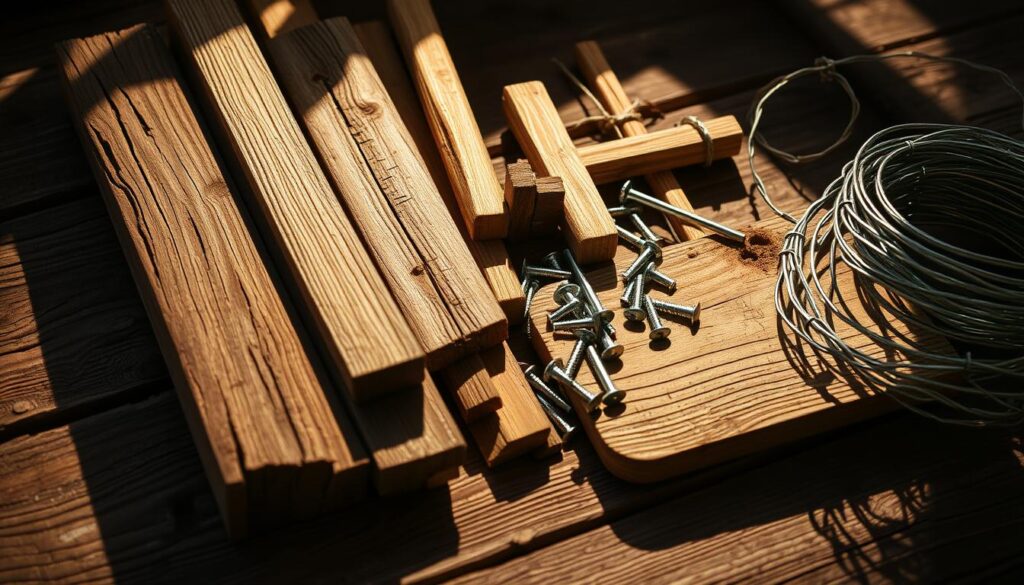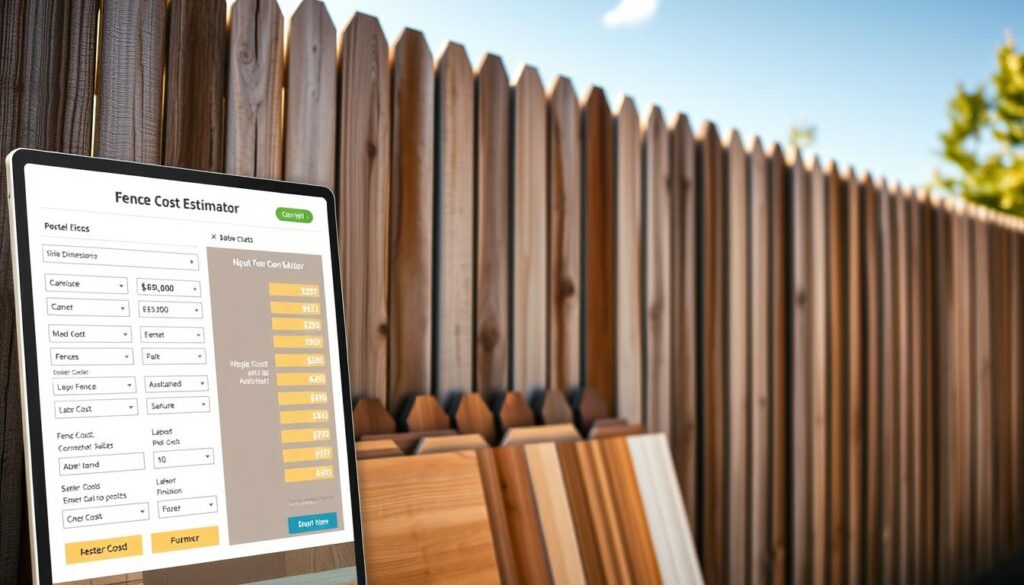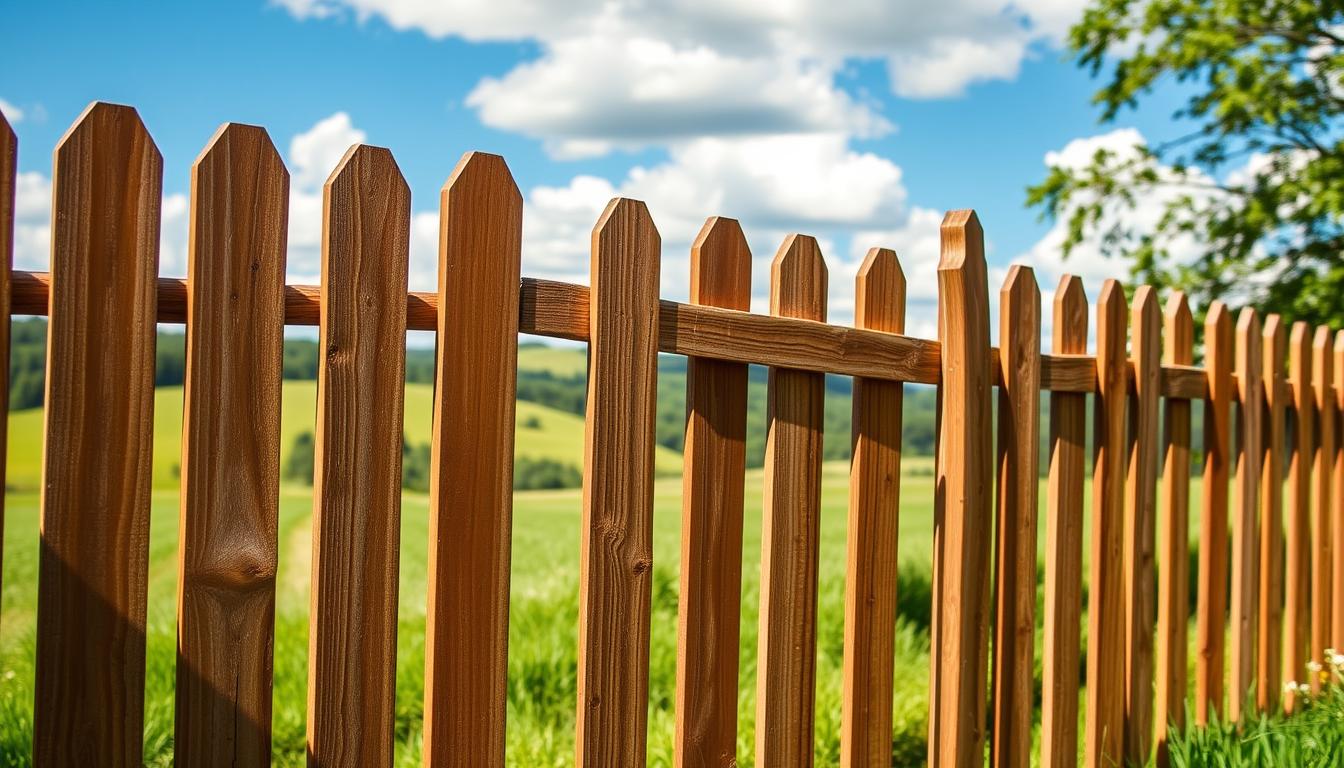Are you considering installing a wooden fence but unsure about the costs involved? The expense of a wooden fence can vary significantly based on several factors, including materials, labor, and the size of your property.
A residential wood fence costs, on average, between $24 to $45 per linear foot, including materials and labor. For a 150-foot fence, you can expect to pay between $3,600 and $6,750. Understanding these costs is crucial for homeowners looking to enhance their property’s privacy and aesthetic appeal.
Key Takeaways
- Average cost of a residential wood fence: $24 to $45 per linear foot
- Total cost for a 150-foot wood fence: $3,600 to $6,750
- Factors influencing the total expense: materials, labor, property size
- Importance of understanding costs for homeowners
- Benefits of wooden fencing for property privacy and aesthetics
Understanding Wooden Fence Pricing Basics
To effectively budget for a wooden fence, it’s essential to grasp the fundamentals of its pricing. The cost of installing a wooden fence can range widely, influenced by several key factors.
Average Cost Range for Wooden Fences
The average cost to install a wood fence ranges from $24 to $45 per linear foot. This cost estimate encompasses the materials and labor required for a standard installation. However, the final cost can vary based on the complexity of the project, including the terrain and any additional features.
Cost Factors at a Glance
Several factors influence the total cost of a wooden fence. These include:
- The style of the fence, such as privacy, picket, or split rail
- The type of wood used, with options ranging from pressure-treated pine to cedar and redwood
- The height of the fence, as taller fences require more materials
- The complexity of the installation, including any obstacles or challenging terrain
Understanding these factors is crucial for using a wooden fence cost estimator effectively and getting an accurate quote for the cost of wooden fence installation.
Types of Wood and Their Price Points
When it comes to wooden fencing, the choice of wood is crucial in determining the final price. The type of wood used can significantly impact the overall cost, durability, and aesthetic appeal of the fence.
Different types of wood vary greatly in price, with costs ranging from $12 to $97 per linear foot, depending on the wood type and fence style. Understanding the characteristics and price points of various wood options is essential for making an informed decision.
Cedar Fencing Costs
Cedar is a popular choice for wooden fencing due to its natural beauty and durability. Cedar fencing costs range from $20 to $40 per linear foot, depending on the quality and grade of the cedar.
- Western Red Cedar is a premium option, known for its resistance to rot and insects.
- Eastern White Cedar is another popular choice, offering a more affordable option with similar benefits.
Pine and Pressure-Treated Wood Costs
Pine and pressure-treated wood are more budget-friendly options, with costs ranging from $12 to $25 per linear foot. Pressure-treated wood is treated with chemicals to resist rot and insects, making it a durable choice.
- Pine is a softwood that is often used for fencing due to its affordability and availability.
- Pressure-treated wood is a cost-effective option that offers long-term durability.
Redwood Fencing Costs
Redwood is a premium wood option, known for its natural beauty and durability. Redwood fencing costs range from $40 to $70 per linear foot, depending on the quality and grade of the redwood.
- Redwood is resistant to rot and insects, making it a long-lasting choice.
- It is also aesthetically pleasing, with a natural reddish-brown color.
Cypress and Other Premium Woods
Cypress and other premium woods, such as mahogany and teak, are high-end options with costs ranging from $50 to $97 per linear foot. Cypress is known for its durability and resistance to rot and insects.
- Cypress is a popular choice for fencing due to its natural beauty and long lifespan.
- Other premium woods, such as mahogany and teak, offer unique aesthetic appeal and durability.
By understanding the different types of wood and their associated costs, homeowners can make informed decisions when selecting the best wooden fence for their needs and budget.
How Much Is Wooden Fences by Style and Design
The style and design of a wooden fence play a crucial role in determining its overall cost. Different styles serve various purposes, from privacy and security to aesthetic appeal, and their prices vary accordingly.
Privacy Fence Costs
Privacy fences are designed to provide seclusion and are typically taller and more robust. The cost for privacy fences can range from $20 to $40 per linear foot, depending on the material and design complexity.
Picket Fence Pricing
Picket fences are a popular choice for their classic look and functionality. They usually cost between $15 to $30 per linear foot. The price variation depends on the height, material quality, and decorative elements.
Split Rail and Ranch-Style Costs
Split rail and ranch-style fences offer a more rustic and open look. They are generally less expensive, with costs ranging from $12 to $25 per linear foot. The simplicity of their design contributes to their affordability.
Decorative and Custom Design Pricing
For those looking for a unique or decorative wooden fence, the costs can be significantly higher, ranging from $30 to $53.50 per linear foot. Custom designs, intricate details, and premium materials drive up the expenses.
| Fence Style | Cost per Linear Foot | Key Features |
|---|---|---|
| Privacy Fence | $20 – $40 | Tall, robust, seclusion |
| Picket Fence | $15 – $30 | Classic look, functional |
| Split Rail/Ranch-Style | $12 – $25 | Rustic, open look, simple |
| Decorative/Custom | $30 – $53.50 | Unique, intricate, premium materials |
When choosing a wooden fence, it’s essential to consider both the style and the budget. Understanding the cost implications of different designs helps homeowners make informed decisions that meet their needs and financial constraints.
Material Costs Breakdown
Breaking down the material costs helps homeowners budget accurately for their wooden fence projects. The total cost of a wooden fence is influenced by several factors, including the type of wood, fence design, and materials required.

Lumber Pricing per Linear Foot
The cost of lumber is a significant component of the overall material costs. Different types of wood have varying prices per linear foot. For instance, cedar fencing is a popular choice due to its durability and resistance to rot and insects, but it comes at a higher cost compared to pine or pressure-treated wood.
- Cedar: $3 to $7 per linear foot
- Pine/Pressure-Treated: $2 to $5 per linear foot
- Redwood: $5 to $10 per linear foot
Posts, Rails, and Hardware Costs
In addition to lumber, the cost of posts, rails, and hardware must be considered. These components are crucial for the structural integrity and functionality of the fence.
- Posts: $10 to $30 each, depending on size and material
- Rails: $1 to $3 per linear foot, depending on the type of wood
- Hardware (nails, screws, etc.): $50 to $100 for the entire project
Stain, Paint, and Sealant Expenses
Finishing touches like stain, paint, and sealants not only enhance the appearance of the fence but also protect it from the elements. The cost of these finishes varies based on quality and brand.
- Stain/Sealant: $20 to $50 per gallon
- Paint: $30 to $60 per gallon
To find cheap wooden fence suppliers, it’s advisable to compare prices from different vendors and consider purchasing materials during sales or discounts.
Labor and Installation Cost Factors
The total cost of a wooden fence is not just about materials; labor and installation play a substantial role. When planning your fence project, understanding these costs is crucial for budgeting.
Professional Installation Rates
Professional installation rates for wooden fences vary based on the complexity of the job, the location, and local labor costs. On average, homeowners can expect to pay between $7 to $20 per linear foot for labor.
To give you a better idea, here’s a breakdown of typical professional installation costs:
| Fence Type | Cost per Linear Foot | Total Cost for 100 Linear Feet |
|---|---|---|
| Simple Picket Fence | $7-$12 | $700-$1,200 |
| Privacy Fence | $10-$18 | $1,000-$1,800 |
| Decorative Fence | $15-$20 | $1,500-$2,000 |
DIY Installation: Cost Savings and Considerations
Choosing to install your wooden fence yourself can significantly reduce labor costs. However, it’s essential to consider your skill level, the time required, and potential challenges.
By opting for DIY installation, you can save on labor costs, which can range from $7 to $20 per linear foot. However, you’ll need to factor in the cost of tools, materials, and any necessary permits.
Regional Labor Cost Variations Across the US
Labor costs can vary significantly across different regions in the United States. Urban areas tend to have higher labor costs compared to rural areas.
For instance, installing a wooden fence in the Northeast or West Coast regions may cost more than in the Midwest or Southern states due to differences in labor rates and living costs.
Using a wooden fence cost estimator can help you get a more accurate quote based on your location and the specifics of your project.
Using a Wooden Fence Cost Estimator
Understanding how to use a wooden fence cost estimator is crucial for homeowners planning a fencing project. A cost estimator helps in determining the total cost of the project, including materials and labor.
Online Estimation Tools
Online cost estimation tools are readily available and can provide a quick estimate of your wooden fence costs. These tools typically ask for details such as the length of the fence, the type of wood, and the style of the fence. For instance, you can compare wooden fence costs on Ergeon’s blog to get an idea of the average costs in your area.
Some popular online estimation tools include:
- Home improvement websites with cost calculators
- Fencing company websites with estimation tools
- DIY forums and blogs with cost estimation guides
When using online estimation tools, it’s essential to input accurate information to get a reliable estimate. Consider factors like the condition of your yard, the complexity of the installation, and local labor costs.

Contractor Quotes and What to Expect
While online tools can provide a preliminary estimate, getting quotes from contractors is crucial for an accurate assessment. Contractors will assess your property and provide a detailed quote that includes materials, labor, and other costs.
When requesting quotes, ensure you provide the same information to each contractor to compare their prices accurately. A typical quote should include:
| Item | Description | Cost |
|---|---|---|
| Materials | Type and quantity of wood, posts, rails, etc. | $X |
| Labor | Cost of installation based on hours worked | $Y |
| Permits and Fees | Any additional costs for permits and inspections | $Z |
As noted by a fencing expert, “Getting multiple quotes is essential to ensure you’re getting the best price for your wooden fence installation.” (“The key to a successful fencing project is not just about the cost; it’s about understanding what you’re getting for your money.”)
Calculating Your Project Budget
To calculate your project budget, start by determining your total budget for the project. Consider not just the initial cost but also long-term expenses like maintenance and potential repairs.
Here’s a simple step-by-step guide to calculating your budget:
- Determine the total length of the fence needed.
- Choose the type of wood and style of the fence.
- Get quotes from multiple contractors or suppliers.
- Factor in additional costs like permits, staining, or painting.
- Consider long-term maintenance costs.
By following these steps and using the right tools, you can create a realistic budget for your wooden fencing project and ensure you’re getting the best wooden fence prices available.
Finding Affordable Wooden Fence Options
The quest for an affordable wooden fence can be daunting, but there are strategies to make it more manageable. Homeowners can explore various avenues to reduce costs without compromising on quality or aesthetics.
Best Times to Purchase Wooden Fencing
Timing is everything when it comes to purchasing wooden fencing. Off-season sales can offer significant discounts as contractors and suppliers look to clear inventory during slower periods. Typically, late winter or early spring is considered off-season for fencing projects, making it an ideal time to snag a deal.
Additionally, keeping an eye on local hardware stores and online retailers for promotional events or holiday sales can yield substantial savings. Many retailers offer discounts during major holidays like Memorial Day or Labor Day.
Comparing Suppliers and Prices
Comparing prices among different suppliers is crucial for finding the best deal. Homeowners should not only look at the cost per linear foot but also consider the quality of the materials and the supplier’s reputation. Online reviews and word-of-mouth referrals can provide valuable insights into a supplier’s reliability and customer service.
It’s also beneficial to request quotes from multiple suppliers to compare prices and services. Some suppliers may offer discounts for first-time customers or for purchasing materials in bulk.
Bulk Purchasing and Discount Opportunities
Buying in bulk can be an effective way to reduce the cost of wooden fencing. Many suppliers offer discounts for bulk purchases, which can significantly lower the overall cost per unit. This strategy is particularly useful for larger projects or for homeowners who are planning to undertake multiple projects.
Furthermore, exploring discount stores or clearance sections can sometimes yield surprisingly good deals on fencing materials, albeit with some flexibility on the type or quality of the material.
By being strategic about when and how you purchase your wooden fencing, you can achieve a beautiful and functional fence without breaking the bank. Whether it’s taking advantage of seasonal sales, comparing supplier prices, or buying in bulk, there are numerous ways to make your wooden fencing project more affordable.
Long-Term Costs and Value Considerations
A wooden fence’s true cost is revealed over time, including maintenance, lifespan, and potential return on investment. Understanding these long-term costs is crucial for homeowners to make informed decisions about their fencing options.
Maintenance Expenses Over Time
Maintaining a wooden fence is essential to extend its lifespan and keep it looking its best. The cost of maintenance can vary significantly depending on the type of wood and the size of the fence. For instance, cedar and redwood fences require less maintenance than pine or pressure-treated wood fences but are more expensive upfront.
Average Annual Maintenance Costs:
| Wood Type | Annual Maintenance Cost per Linear Foot |
|---|---|
| Cedar | $0.50 – $1.00 |
| Pine/Pressure-Treated | $0.75 – $1.50 |
| Redwood | $1.00 – $2.00 |
Lifespan and Replacement Factors
The lifespan of a wooden fence varies widely based on the wood type, environmental conditions, and maintenance quality. Generally, a well-maintained cedar or redwood fence can last 15 to 20 years or more, while pine or pressure-treated wood fences may need replacement within 10 to 15 years.
Factors Influencing Lifespan:
- Exposure to weather conditions
- Soil quality and moisture levels
- Pest and disease resistance of the wood
- Regular maintenance and repairs
Return on Investment for Different Wood Types
The return on investment (ROI) for a wooden fence can be significant, especially if it enhances the property’s curb appeal and functionality. The choice of wood type plays a crucial role in determining the ROI. For example, durable and aesthetically pleasing woods like cedar and redwood can offer a higher ROI compared to more economical options like pine.
When calculating the ROI, homeowners should consider factors such as the increased property value, potential savings from reduced maintenance or repair costs, and the overall enhancement of the property’s appearance.
Conclusion: Making the Right Wooden Fence Investment
Understanding the factors that influence wooden fence costs is crucial for homeowners to make informed decisions and invest in a fence that meets their needs and budget. The cost of wooden fence installation can vary significantly based on the type of wood, style, and design chosen.
By considering the average cost range for wooden fences, types of wood and their price points, and labor and installation cost factors, homeowners can better estimate the total cost of their project. Using a wooden fence cost estimator and comparing suppliers and prices can also help in finding affordable options.
Ultimately, investing in a wooden fence requires careful consideration of both initial and long-term costs, including maintenance expenses and potential return on investment. By making an informed decision, homeowners can enjoy a beautiful and functional wooden fence that enhances their property’s value.

